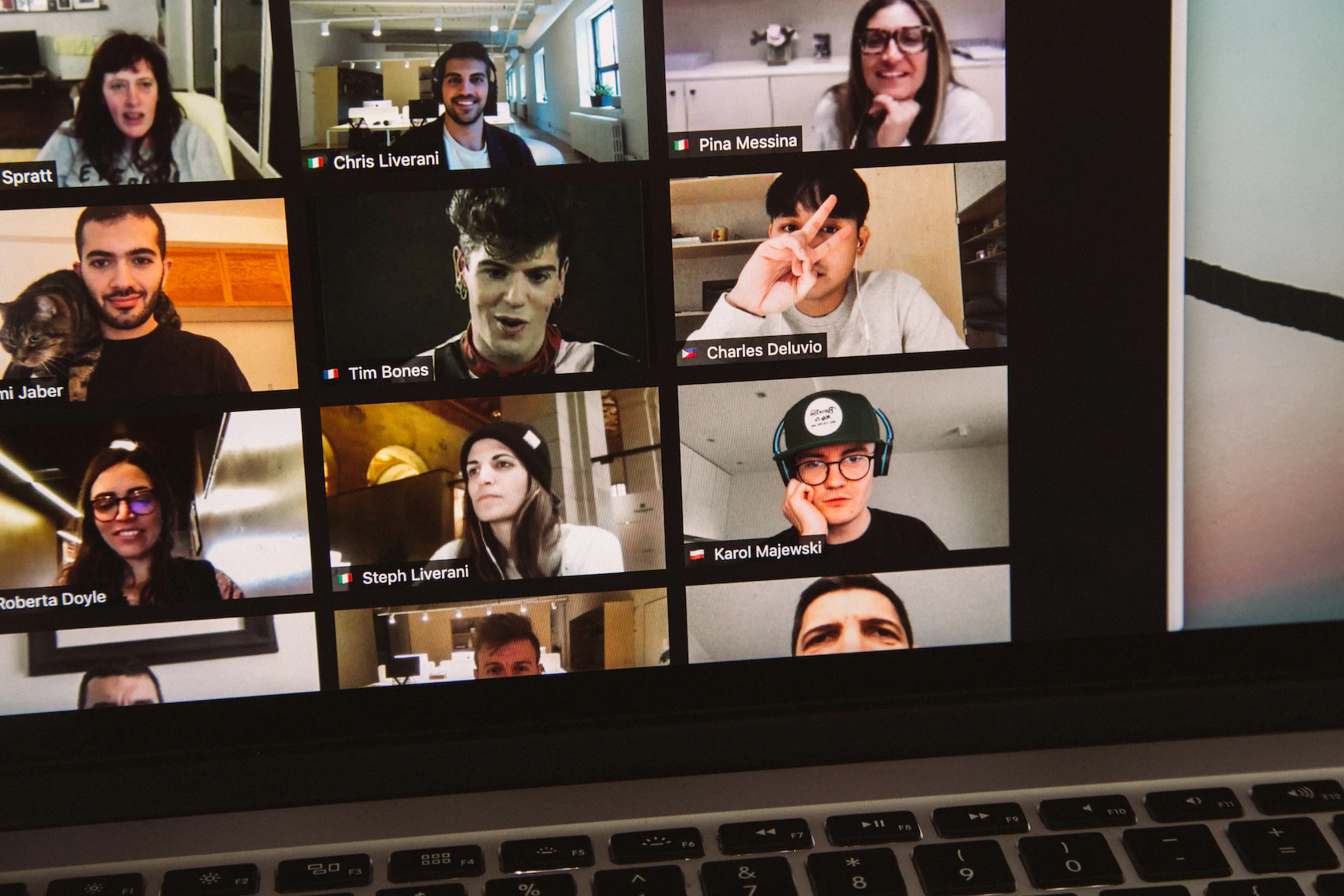The Do's and Don'ts of virtual meetings
For many of us it feels like just yesterday that meetings involved pouring into a conference room to sit around an abnormally large table. They used to involve idle chit-chat and small talk before and after as we waited for the other attendees to arrive. Presentations were given with the aid of a big TV or projector screen and the location of the meeting was dependent on how many people needed to be accommodated.

While the traditional in-person meetings still happen every day, the advent of a digital transformation era has meant that more and more meetings are being conducted in a virtual capacity. In fact, 83% of employees now spend more than a third of their week in virtual meetings.
The virtual or hybrid model of meeting is here to stay, but for many of us, the transition from physical to virtual meetings happened so fast that there wasn’t a great deal of time to adjust to this new way of conducting one of the most common activities of business.

So is there a right and wrong way to conduct a virtual meeting? What are the best practices to remember when taking part in one? What can you do to ensure that your virtual meetings are run effectively and professionally one hundred percent of the time? We have it covered for you with a guide to the do’s and don’ts of virtual meetings.
Shortcuts:
- What is a Virtual Meeting?
- What Should You Do in Virtual Meetings?
- Always Be On Time
- Set an Agenda
- Check your Internet Connection
- Maintain a Positive Atmosphere
- Share Your Screen when Appropriate
- Share Files and Information Before the Meeting
- Maintain Eye Contact
- Pay Attention and Focus
- Dress Appropriately For Each Meeting
- Know When to Mute Yourself
- Know When you Need to be on Camera and Not
- Fix Your Background
- What Should You Not Do in Virtual Meetings?
What is a Virtual Meeting?

A virtual meeting is a type of meeting that takes place online, rather than in person. It allows people to connect and communicate with each other remotely, using computers, smartphones, or other internet-enabled devices.
During a virtual meeting, participants can see and hear each other through video and audio technology, and can share documents, images, and other information through the internet. Virtual meetings are a convenient and efficient way for people to collaborate and work together, even when they are not physically in the same location.
What Should You Do in Virtual Meetings?

Conducting yourself correctly in virtual meetings is important for success at work and in business. It may be a recent innovation, but there is a proper etiquette that should be followed. By following the guidelines below, you can establish yourself as a reliable and respectful colleague, which can help you build strong working relationships and achieve success in your career or business.
Always Be On Time
Have you ever found yourself in a situation where you’re waiting for a key participant to arrive at a meeting? It’s a common problem, both in virtual meetings and in-person gatherings.
Time management can be a major challenge, especially when meetings are only scheduled for an hour. If attendees are just a few minutes late, there isn’t much time left for the actual discussion once small talk is out of the way. If the meeting goes over its allotted time, the next meeting may start late, leading to a continuous cycle of delays.
Being on time is the best way to maximise your time and show colleagues and business partners that you respect theirs; In fact, some experts believe that in order to get the most out of virtual meetings, it’s best to adopt an attitude that ‘early is the new on time.’
Set an Agenda
An effective meeting, whether virtual or in-person, requires a clear and structured agenda. This is especially important for video conferences, as it helps to ensure that the meeting runs smoothly and efficiently. To make this process easier, it can be helpful to store the meeting schedule in a shared cloud, where it can be easily accessed and shared with attendees. This allows everyone to see the basic outline of the meeting and can also be useful for those who are unable to attend but want to review the information later.
Check your Internet Connection
If you try to start a virtual meeting and your microphone or webcam isn’t working, you may appear unprofessional and unreliable. To avoid this, it’s important to test your conferencing setup in advance, making sure that your software can detect your microphone or headphones.
You should also check that your internet connection is strong enough to support a video conference. If it’s not, some applications allow you to lower the video quality or turn off your camera so that you can still participate audibly. Remember, even if you’re not present on video, it’s still important to stay engaged and follow the conversation. Keep in mind that some people may not want to use the video feature for various reasons, such as being in a shared space with children or pets, or simply not wanting to be seen at that moment.
Maintain a Positive Atmosphere
Even if you’re participating in a virtual meeting from a distance, it’s important to be courteous and positive towards the other attendees. This means you should pay attention to each speaker, minimise distractions, and focus on the task at hand.
A helpful tip for video conferences is to smile and exude confidence. This can help to create a positive and friendly atmosphere during the meeting. These simple strategies can go a long way towards making virtual meetings productive and enjoyable for everyone involved.
Share Your Screen when Appropriate

If you decide you are going to share your screen in a virtual meeting, it’s vital that you check which web pages, chats, applications and documents you have open and activate ‘Do Not Disturb’ functionalities on your devices. Often, screen sharing can mean that everything that appears on your screen will also appear on the screens of your participants.
Professional screen sharing software like CrankWheel can also help to give you the utmost control over what is shared and take the presentation experience to another level entirely.
Share Files and Information Before the Meeting
In order to elicit participation and collaboration from your team during a virtual meeting, it is integral to provide them with the necessary information beforehand. This can be accomplished by sharing relevant documents and materials beforehand, rather than relying on in-person methods like physical whiteboards or spreadsheets.
By preparing and sharing these materials before the meeting, you ensure that all team members have the context they need to contribute effectively. During the meeting, you can also use screen sharing tools to navigate and discuss documents together, ensuring that everyone is working from the same set of information.
Maintain Eye Contact
Maintaining eye contact during a virtual meeting is important for several reasons. First and foremost, it shows that you are engaged and paying attention to the discussion. When you make eye contact with others in the virtual meeting, you convey that you are interested in what they have to say and are actively listening. Additionally, maintaining eye contact helps to establish a sense of connection and rapport with others in the meeting, even if you are not physically present in the same location. It can also help to create a more professional and respectful atmosphere, as it demonstrates that you are taking the meeting seriously.
The simplest way to achieve the illusion of in-person eye contact is to make sure your camera is directed towards your face, and to place the window of the participants as close to that as possible.
Pay Attention and Focus
While it may be tempting to tune out or disengage during a virtual meeting, it is important to remain focused and actively participate just as you would in an in-person meeting. This means refraining from multitasking or getting distracted by other tasks or devices.
One way to stay engaged is to take notes and actively assimilate the information being discussed. However, it is also important to resist the temptation to switch between tabs or check your phone, as this can significantly reduce your ability to fully participate in the meeting. Even if you feel confident in your multitasking skills, it is still essential to give your full attention to the virtual meeting in order to get the most out of it.
Dress Appropriately For Each Meeting
While it can be tempting to prioritise comfort when working from home, it is important to remember that virtual meetings often require a level of professionalism and decorum. This includes dressing appropriately for the occasion, even if you are just participating via video conference.
It’s totally fine to wear comfortable clothing when working from home, it is important to avoid anything too casual or inappropriate if you will be on camera. Additionally, it is always a good idea to be mindful of your surroundings and ensure that you are presentable in case you need to stand up or move around during the meeting. A little bit of effort can go a long way in maintaining a professional image and ensuring that your colleagues take you seriously.
Know When to Mute Yourself
It is important to remember to mute yourself when not speaking during a virtual meeting, even if you are the only participant aside from the presenter. This is because background noise can easily be picked up by the microphone, potentially disrupting the flow of the meeting.
While it is completely normal and understandable to have household noises in the background, it is still important to minimise distractions and ensure that the meeting runs smoothly.
Additionally, it is always a good idea to be mindful of your surroundings and try to find a quiet location for the meeting if possible.
Know When you Need to be on Camera and Not
It is beneficial to have your camera on during a virtual meeting in order to foster a sense of collaboration and connection with your team, but there are certainly times when it is okay to turn it off. For example, if you have a needy pet or children in the background who may be disruptive, it may be necessary to turn your camera off in order to minimise distractions.
Similarly, if you are not feeling well or simply prefer to keep a low profile, it is okay to turn your camera off as well. The important thing is to be mindful of your surroundings and ensure that you are not disrupting the meeting or causing unnecessary distractions.
Fix Your Background
Virtual meeting platforms like Microsoft Teams and Zoom offer the ability to customise your background, which can be especially useful if your workspace is less than ideal or if you prefer to keep your personal space private. You can choose to use your normal background if you have a dedicated home office, or you can blur your background if you are working in a shared space like the kitchen or bedroom.
Many platforms also offer a selection of preset backgrounds to choose from, or you can even create your own custom background if you have the skills and resources to do so. Regardless of which option you choose, the important thing is to find a background that is professional and appropriate for the meeting, and that does not distract from the discussion or cause any technical issues.
What Should You Not Do in Virtual Meetings?

Avoid Multitasking
Avoiding multitasking is an essential rule to follow in any virtual meeting, especially when you are presenting. Not only is it unprofessional and disrespectful to your colleagues, but it can also be extremely disruptive and confusing for everyone involved. When you are sharing your screen and presenting, it is important to stay focused and avoid opening emails, chats, personal files, or pictures that have nothing to do with the meeting. This helps to keep the meeting on track and ensures that everyone is able to follow along and fully participate. While it is understandable that we all have busy schedules and many competing demands, it is important to make an effort to pay attention and stay on task during virtual meetings in order to make the most of your time and get the best results.
Don’t Eat

It is generally considered poor etiquette to eat during a virtual meeting, as it can be distracting and unprofessional for everyone involved. Not only can the sight of someone eating be unpleasant for other participants, but the sounds of chewing or slurping can also be disruptive and make it difficult to follow the discussion.
Don’t Interrupt Anyone
It is important to remember to let others speak without interrupting them during a virtual meeting. This is especially true during brainstorming sessions or other discussions where everyone is encouraged to share their ideas. Allowing each person to have a turn without being interrupted not only helps to ensure that all voices are heard, but it also fosters a sense of respect and collaboration among team members.
Imagine if you were in a debate and someone constantly talked over you or interrupted you – it would be extremely frustrating and make it difficult to get your point across. The same principle applies to virtual meetings. By showing respect for others and allowing everyone to speak without interruption, you can create a more productive and harmonious virtual meeting experience
Avoid Typing Constantly

It is integral to be mindful of the sounds you make during a virtual meeting, as they can be easily picked up by the microphone and be very distracting for others. One common issue is the sound of constant typing, which can be especially loud and disruptive over the microphone. If you need to take notes or type during a meeting, it is best to do so as quietly as possible or to use a headset to mitigate the noise.
Alternatively, you can also consider jotting down notes in a notebook rather than typing on your computer.
Don’t Invite Unnecessary People
Be mindful of who you invite to a virtual meeting, as including unnecessary people can be a waste of time and resources for everyone involved.
Before sending out an invitation, consider whether each person will be able to contribute value to the discussion or whether their presence is necessary for the meeting to be productive. It is not productive to simply invite more people to a meeting for the sake of having more bodies present, as this can lead to confusion and a lack of focus. By being selective and inviting only those who will be able to contribute to the discussion, you can ensure that your virtual meetings are efficient and effective.
It’s also a great idea, before you even schedule the meeting to ask yourself if this could be an email instead.
Don’t Attend a Meeting in Leisurewear

Yes, nobody is physically going to see you when you work from home so it’s very tempting to get those reports done in your PJs but, during a meeting, professional attire is still expected. Even if you are not on camera for every meeting, there is always a possibility that you will be at some point, and it is important to be prepared.
Dressing appropriately for a virtual meeting is a simple yet effective way to show respect for your team and to convey a professional image. By taking the time to dress appropriately, you demonstrate that you take the meeting and your work seriously, and you set a good example for others to follow. At the same time, it is important to remember that your team members are also working from home and are likely making an effort to dress appropriately as well.
Avoid Too Much Background Noise
Be mindful of the amount of noise in the background during a virtual meeting, as it can be distracting and make it difficult for everyone to stay focused on the task at hand. This includes avoiding having loud music or TV shows playing in the background, as well as other sources of noise that could disrupt the flow of the meeting.
If you are working from home and sharing the space with others, it is a good idea to let them know about the meeting beforehand and request that they avoid making noise or doing things that could interrupt the call. This could include activities such as vacuuming or using loud appliances (like washing machines).
Don’t Fail to do your Background Homework
Doing your background homework before attending a virtual meeting will help you to be fully prepared and able to contribute to the discussion. This may include reviewing any relevant documents or materials, familiarising yourself with the agenda, and thinking about any questions or points you may want to raise.
By doing your background homework, you can ensure that you are fully engaged and able to make the most of the meeting, as well as show respect for the time and efforts of your colleagues.
Conclusion
The remote working revolution we have experienced in the last few years has helped to pave the way for better opportunities when it comes to work-life balance, what is possible for small to medium sized businesses and many more aspects of business. Becoming familiar with the best practices of virtual meetings will ensure that you are in the best possible position for virtual meeting success.
